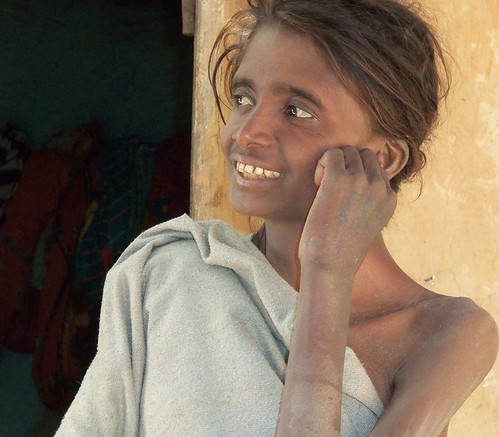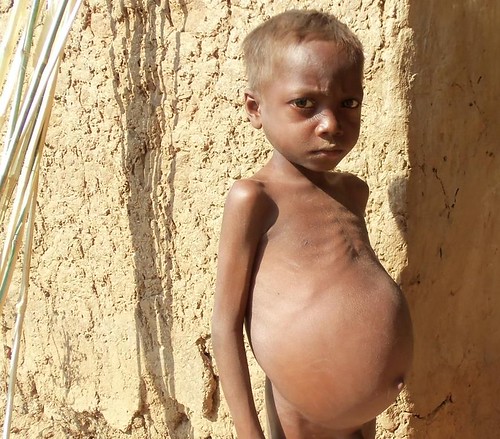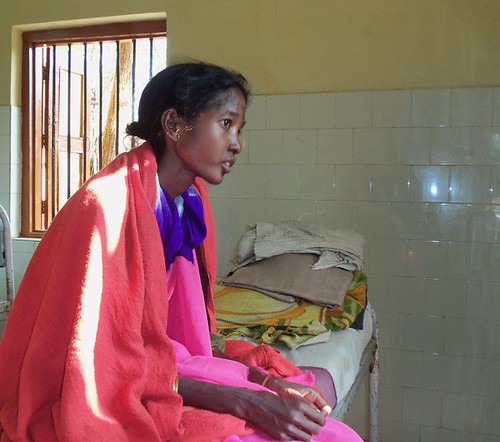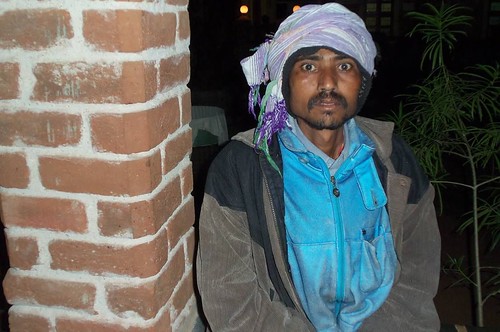By Somnath Mukherji,
Phagni Bai Baiga’s smile can melt hearts. I wonder where she finds the strength to smile so beautifully in equanimity. But then again, perhaps that is what propels her through life with the odds stacked so heavily against her and the community she belongs to.
When I met her at her parents’ home in Littikhola, a small village at the base of the mountain, in Bilaspur district of Chhattisgarh, she had wrapped a shawl around herself because the two sarees she owns were drying out after a wash.

On asking how she was, she smiled half-coyly and said “Good”.
“And your son?” I persisted.
Translating from Chhattisgarhi, my friend explained that – according to her, the boy was also better and she thought that the swelling of his stomach had gone down. This too, I suppose was her survival mechanism like her smile that was incongruous and life-giving at the same time. The condition of both had actually worsened.
Phagni’s husband had contracted Tuberculosis 2 years ago but was cured through treatment and regular follow up from Jan Swasthya Sahayog (JSS) in Ganiyari, Bilaspur – a unique model of high quality, rational healthcare system for rural India. A year later Phagni, a mother of 4 then started showing symptoms of TB but did not come to JSS fearing that she would have to arrange for another Rs 700 like her husband. So she suffered and wasted in her remote village of Kurdar on top of the mountain. A few months later her 9 year old son started wasting away.

|
Phagni Bai Baiga |
Age: 30 yrs |
Ht: 151cm |
Wt: 25.7 Kg |
BMI: 11.3 |
|
Raja Kr. Baiga |
Age: 9 yrs |
Ht: 91cm |
Wt: 10 Kg |
BMI: 12 |
Body Mass Index (BMI) defined as weight over height squared is used as a surrogate for nutritional status of people. A high BMI indicates obesity and a low one under-nutrition. A quick online survey of the literature on BMI by a layperson like me gave the impression that the academia, corporate and governments are concerned mainly with the upper end of the spectrum – not a surprise.
A BMI of less than 18.5 signifies chronic undernourishment and below 16 it enters a range where the body fat content is supposed to be incompatible with life. This is why Phagni Bai smiles and says all is well; this is how she fights her incompatibility in a society of rising GDP.
Why?
The main source of livelihood for Baiga families in Kurdar is weaving baskets out of bamboos collected from the forest. These baskets sell for 15 to 20 Rupees a piece. One has to walk up to 5 hours one way to gather bamboo evading the vigilant eyes of the forest department. When her husband was sick Phagni was the only one fit to work, reducing their income to Rs 300 a week with which they could not buy enough broken rice from the market to supplement the monthly 35 Kg at Re. 1 they get from the ration shop. When they had to buy rice, they ate less. As her husband recovered Phagni became too weak to work, passing on the mantle of earning a livelihood to her husband.
The disproportionately large appearance of Phagni’s shoulder joints, her high collar bone lurking from beneath her cloth, the swollen belly of her child tell about the vicious cycle of losing control over natural resources, loss of livelihood, food insecurity and ill-health like no one can – not even Phagni herself.
Ramkali Baiga

Sitting on the hospital bed in JSS, Ramkali had difficulty lifting the hand-woven cotton saree that Baigas traditionally wear. As she laid it out on the bed, her wrists seemed oversized in comparison to her forearms.
“This keeps us cool in the summer and warm in the winter,” she said about the Kaniyari.
“Does it really” I expressed amazement.
“Hao!” Yes, she nodded and a smile crossed her face – just like it would for a healthy 22 year old woman.
“But these are cheaper,” she explained rubbing the synthetic fabric she was wearing.
She owns 3 of those, bought for Rs 80 each whereas the Baiga sarees, rendered incompatible by the market system costs Rs 300.
|
Ramkali Baiga |
Age: 22 yrs |
Ht: 147cm |
Wt: 24.6 Kg |
BMI: 11.38 |
Why?
Hunger! Married to a Baiga family across the border in Madhya Pradesh Ramkali had to walk 10 hours to get to her in-laws. The landless family survived on broken rice bought from the market thus severely restricting the intake of each individual. Her father-in-law died of TB followed by her husband. With a severely compromised immune system due to inadequate food intake, it was only natural for Ramkali to get infected by TB.
“He was emaciated like me,” she explained nonchalantly.
“Any treatment?”
“Suji – botel,” she replied referring to the quacks that push injections and administer a bottle of saline for most maladies.
Before coming to JSS, Ramkali was living with her parents in the village of Bijrakachar. We caught up with Ramkali’s parents Mahuku and Mangli Baiga cooking dinner in the open field across the road from JSS. Forty to fifty families that come from as far as Rewa district in MP spend several nights in the JSS campus waiting for their turn. Their faith is not unfounded.
“If we had more rice at home, we would cook more,” explained Mahuku.
Over the years they have been losing access to the fruits, herbs and animals from the forest. “Parts of the forests have illegally been taken over by some people who use it rear cattle to sell milk in the cities,” – Mahuku’s agitation was palpable.
Although the family owns 5 acres of land, it yields only 3 quintal of rice. A plot of that size in a moderately fertile area would yield anywhere between 40 to 50 quintals.
Mahuku remembers Bewar (slash and burn agriculture) from his young days, in which they would scatter seeds of Kutki, Maria, Salihar, Bajra, Makka, Jhimga and many more. Such agriculture is not allowed today and the varied nutrition such grains provided has been replaced solely by rice. These are incompatible grains in a world of growing packaged and processed food. Diversity manufactured by the market system alone is compatible everything else has to be normalized – language, culture, grains and worldviews!
Ramkali hasn’t gained any weight in the last 10 days she has been in the hospital. Doctors are concerned. Next morning I stood silently at the door and watched the dark fluid flow down the plastic tube and patiently enter Ramkali’s body a drop at a time. Could this compensate for what the society has sucked out of her? Her slight frame rose and fell underneath her torn blanket – another day she is alive, another day the injustices that led to her condition go unacknowledged and another day she wishes she was taking care of her 5 year old daughter in the village of Bijrakachar.
Dhansaye Nagone
On my way back to Bilaspur after my brief stay at Ganiyari, the headlights shone on a thin frame of a man in a blue fleece and a cloth wrapped around his head and ears. I sat up in my seat as I recognized him to be Dhansaye Nagone who I had been talking to at JSS. He was hanging from the edge of a diesel auto-rickshaw, much like how he survives in an economic system that counts on his cheap labour without letting him count on a decent survival.
Thirty six year old Dhansaye was just 43 Kg in May 2010 when he was caring for his sister with TB in JSS.

“At that weight he was already susceptible,” explained Dr. Jain of JSS, looking through Dhansaye’s history in the OPD. In the intervening 10 months Dhansaye lost another 8 Kg. Despite such tell tale signs, a major medical institution in Bilaspur failed to diagnose him. Dhansaye spent Rs 550 buying medicines completely useless to cure his condition.
“I asked the doctor to take a better look since my sister had already fought with TB a few months ago. But the doctor shooed me away,” Dhansaye said with resignation.
Uncompassionate, expensive, irrational, un-contextual healthcare is as much a killer for the poor as diseases themselves.
Dhansaye lives with his wife and 3 children in the city and earns a livelihood by driving a cycle-rickshaw and brings home up to Rs 75 a day. The family pays a monthly rent of Rs 400 and an electricity bill of Rs 100 and lives mainly on 35Kg of grains (15Kg wheat + 20 Kg rice) bought at a BPL price of Rs 2 per Kg from the ration shop.
The poor of India, specially the adivasis are caught in a vice grip of a policy regime that must transfer common property resources to private entities for profits to boost the GDP, displacing the lives and livelihoods of those who live close to the land. Further, the centralizing nature of the global economy fuelled by subsidized energy is displacing all forms of non-mechanized and decentralized production eliminating millions of livelihoods resulting in increased food insecurity. According to economist Utsa Patnaik, the average Indian family’s grain consumption has fallen by 110 kg between 1991 and 2005.
In 2011, JSS treated 587 cases of TB with the average patient BMI of 16.17 – a substantial increase over 470 cases in 2010.
Rising GDP at the cost of falling BMI certainly does not bode well for the health of the nation.
—-
Somnath Mukherji is a volunteer with Association for India’s Development (http://www.aidindia.org )

